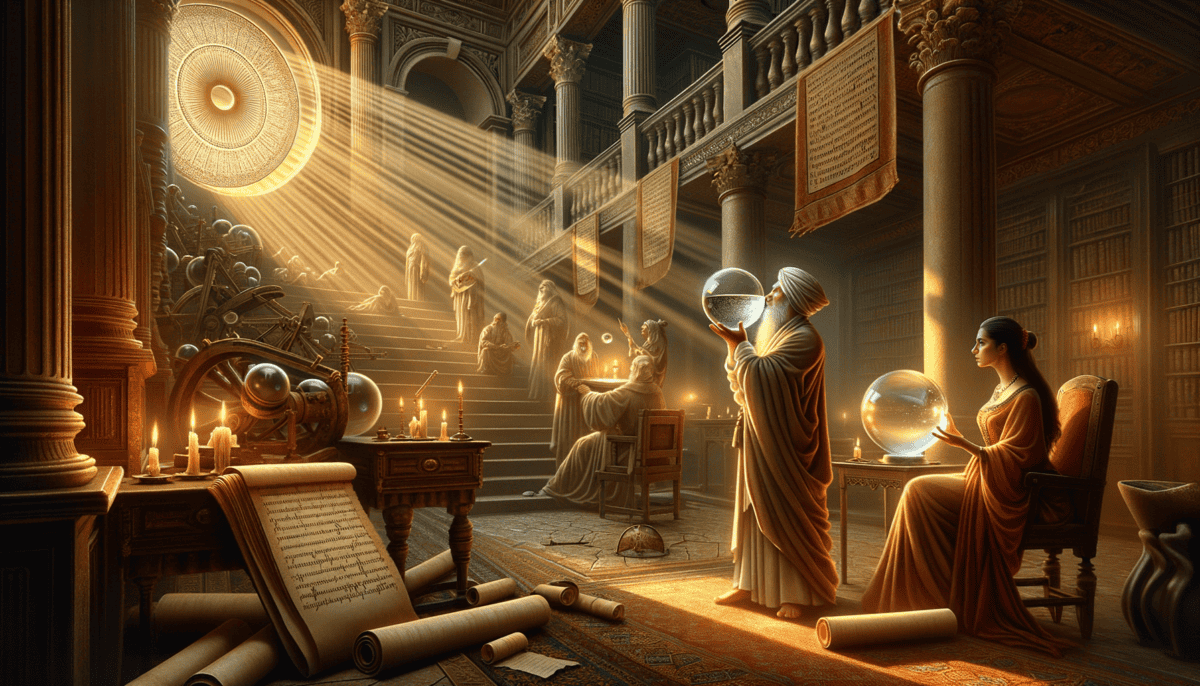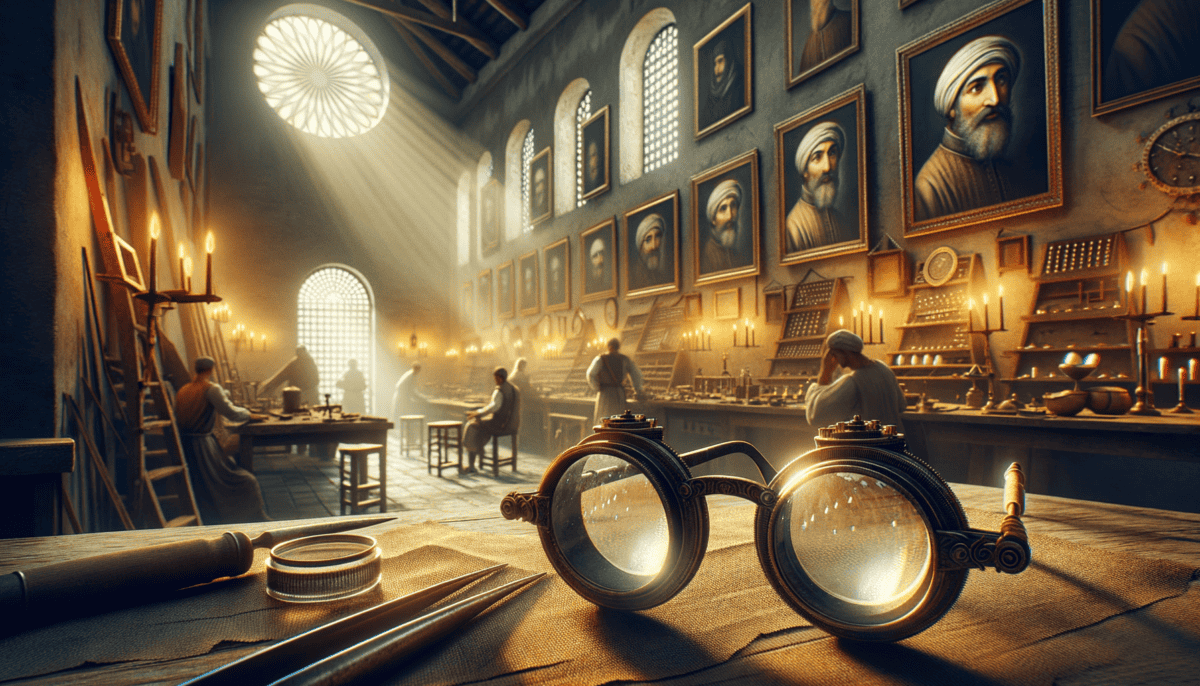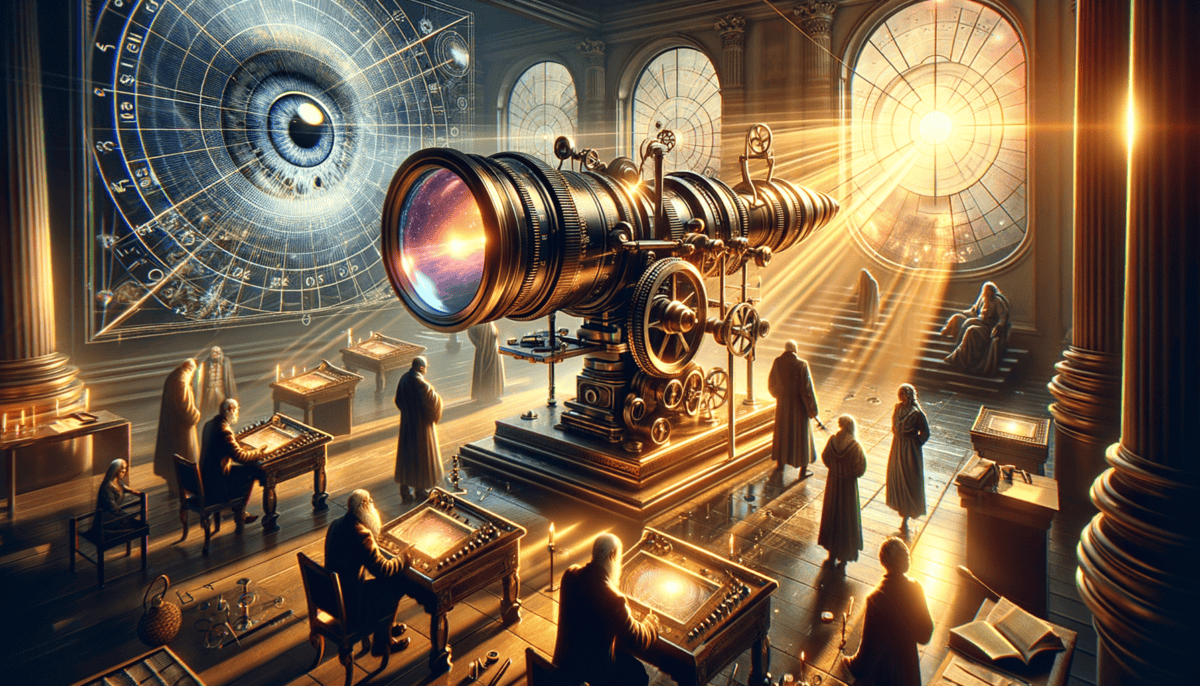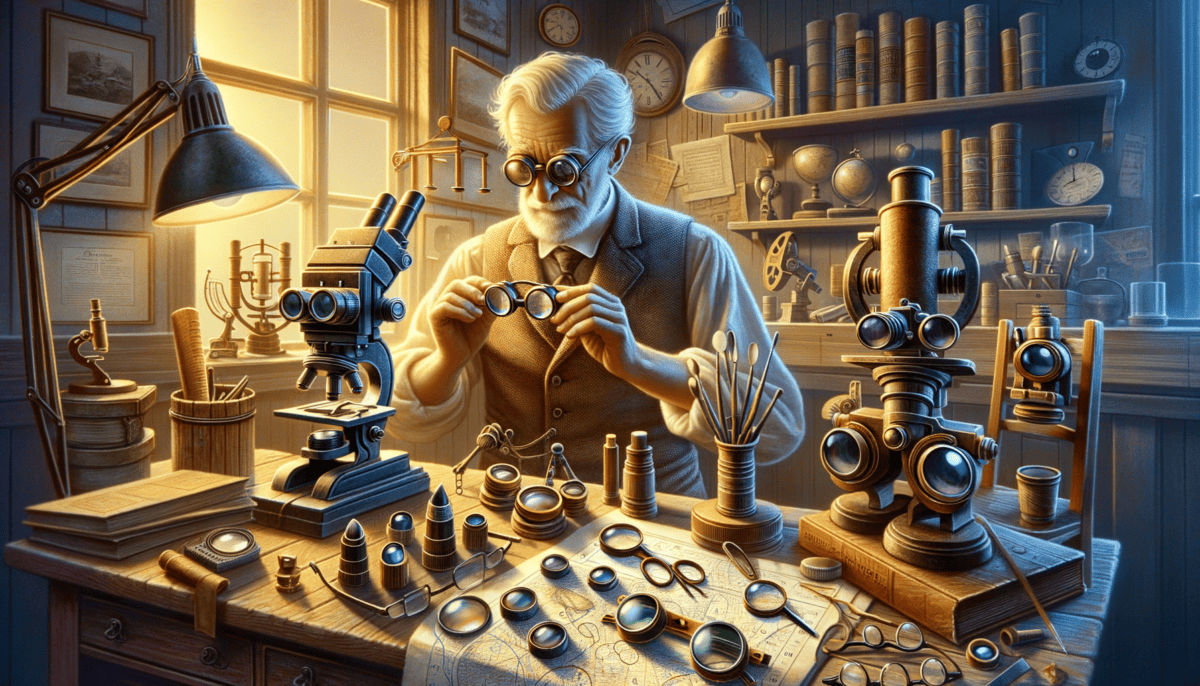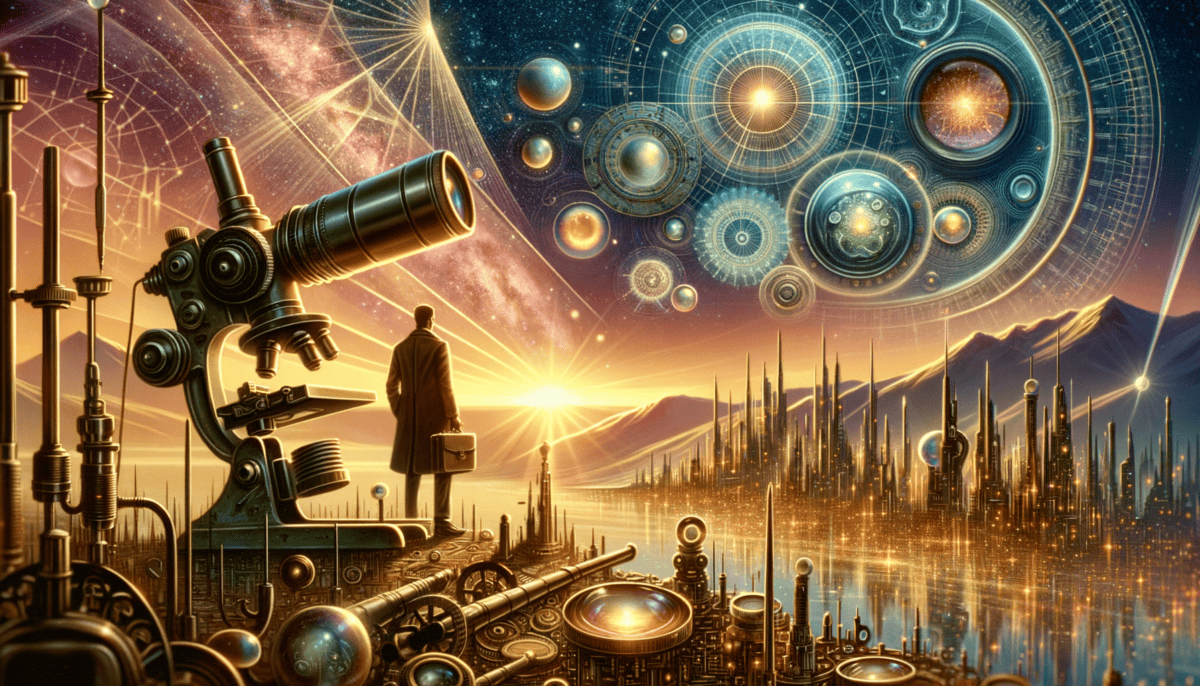A World Without Clear Vision
Long ago, in a time before glasses existed, Marcus sat squinting at the fuzzy shapes moving in the distance. The young boy was only eight, but he knew something wasn't right with his eyes. Everything far away looked like smudgy watercolor paintings.
"Papa, why can't I see the birds clearly like you can?" Marcus asked, tugging at his father's sleeve.
His father, a skilled craftsman in ancient Rome, looked down at his son with concern. "Some eyes need help to see better, my boy. But we haven't discovered how to fix that yet."
Marcus wasn't alone. Many people in ancient times struggled to see clearly. Old scrolls tell us that nearly everyone over 40 had trouble reading. Young people like Marcus who were born with blurry vision had no way to fix it.
"What do you see when you look at the temple?" Marcus's father asked, pointing to the grand building across the forum.
Marcus squinted harder. "It's like looking through foggy water, Papa. The columns all blend together."
Here are some ways ancient people tried to help their eyes:
- Using bright sunlight to read
- Holding things very close to their face
- Having others read to them
- Squinting really hard
- Using magnifying crystals
"I heard the emperor's scribe uses a glass globe filled with water to make letters bigger," Marcus said excitedly. "Could we try that?"
His father smiled. "Perhaps. But imagine if someone could create something better – something that could help everyone see clearly."
As the sun set over Rome, casting long shadows across the forum, Marcus dreamed of a future where blurry vision wouldn't hold anyone back. He didn't know it then, but humans would spend centuries searching for ways to improve their sight.
The stars began twinkling above, though to Marcus they looked like fuzzy dots of light. As he walked home with his father, he wondered if someday, someone would find a way to make the world crystal clear for everyone.
The next morning, Marcus watched a craftsman working with glass. The man heated and shaped the clear material with amazing skill. "Papa, do you think someone could make glass that helps eyes see better?" Marcus asked thoughtfully.
His father patted his shoulder. "The gods gave humans clever minds, my son. Perhaps one day, someone will solve this puzzle."
Across the ancient world, from Rome to China, from Egypt to Greece, clever people were already thinking about ways to help human eyes see better. They were taking the first steps toward an invention that would change the world – optical lenses.
Marcus watched the glassmaker work, his mind full of possibilities. Even though he couldn't see the distant world clearly, he could see hope for the future. And sometimes, that's where the greatest inventions begin – with a simple wish to make life better.
Crystal and Water – First Glimpses of Magnification
A warm breeze rustled through the bustling marketplace of Alexandria, Egypt, where curious minds gathered to share knowledge. Amara, a young girl fascinated by light and vision, watched as merchants displayed their sparkling crystals.
“Look what happens when I hold this crystal over my scrolls!” Amara called out excitedly to her teacher, Theon, a wise scholar at the great Library of Alexandria.
Theon smiled warmly. “Ah, you’ve discovered something special, young one. The ancient Greeks found that rounded pieces of crystal can make things look bigger.”
“But how does it work?” Amara asked, turning the crystal in her hands.
“Watch this,” Theon said, pulling out a glass bowl. He filled it with water and held it over some hieroglyphics carved in stone.
Amara’s eyes widened. “The pictures look bigger through the water too!”
- Clear crystals like quartz
- Glass bowls filled with water
- Polished pieces of glass
“In Rome,” Theon explained, “craftsmen use glass balls filled with water to help them do detailed work. Some scholars even use them to read tiny writing.”
Amara picked up another crystal. “This one makes things look different than the first one.”
“Yes! Different shapes bend light in different ways. Some make things look bigger, some smaller, and some can even flip images upside down!”
Later that day, Amara sat in the garden, experimenting with drops of water on leaves. “Theon, look! Each water drop makes a tiny magnifying glass!”
“Nature teaches us many secrets,” Theon nodded. “These discoveries about light and vision will lead to wonderful things someday.”
As the sun began to set, casting golden light through the crystal Amara held, she imagined all the possibilities these discoveries might bring. “Do you think someone will find a way to help people see better?”
“The path of discovery is like a torch being passed from one curious mind to another,” Theon replied. “Each generation builds on what came before.”
That night, Amara wrote in her diary about all she had learned. She drew pictures of crystals, water bowls, and the way light bent through them. She didn’t know it then, but she was part of a long chain of curious people whose discoveries would eventually lead to the invention of glasses.
The next morning, merchants from distant lands arrived with new types of crystals. Each one showed something different about how light moves and how we see. These simple discoveries would spark ideas that would change how humans see their world forever.
As Amara continued her experiments with light and vision, she was taking part in humanity’s great journey toward clearer sight. The simple wonders she found in crystals and water drops were just the beginning of an amazing story about how humans learned to improve their vision.
The Italian Renaissance of Sight
In a small workshop in Venice, Italy, during the late 1200s, a craftsman named Marco held up a piece of glass to the sunlight streaming through his window.
“Papa, what are you making?” asked his daughter Sofia, watching him carefully shape the hot glass.
“Something special, little one. Watch this!” Marco placed the curved piece of glass over a book. The words grew larger, clearer.
Sofia clapped her hands. “It’s like magic! Just like the water drops we saw in the garden!”
The streets of Venice were filled with skilled glassmakers. Each day, they discovered new ways to shape glass into useful things. But Marco had a different idea – he wanted to help people who couldn’t see well.
• Made from special Venetian glass
• Looked like two magnifying glasses held together
• Helped older people read better
• Changed people’s lives forever!
“Look what happens when we put two pieces together,” Marco demonstrated, holding up his creation. It was the world’s first pair of wearable eyeglasses!
News spread quickly through Venice. Soon, monks who spent long hours copying books came to Marco’s workshop. “These glass circles help us see the letters clearly again!” they exclaimed.
Sofia watched as more and more people visited their workshop. Young scholars, old merchants, and even nobles came seeking these magical glass tools.
“Papa,” Sofia asked one evening, “how did you know how to make these?”
Marco smiled. “Remember the great scholar Alhazen’s books about light and vision? His ideas helped us understand how our eyes work. When we know how something works, we can find ways to make it better.”
“The eye is like a window, and these glasses help the window see more clearly.” – Marco explained to Sofia
In workshops across Venice, more craftsmen began making eyeglasses. Each maker added their own special touch, making the frames more comfortable or the lenses clearer. ️
One day, a traveling merchant visited their workshop. “These are amazing!” he exclaimed. “People all over Europe need these. May I take some to sell in other cities?”
Soon, eyeglasses were traveling across Europe. They went to Paris, London, and even as far as Germany. Each pair helped someone see their world more clearly.
Sofia grew up watching how her father’s invention changed lives. She learned to make glasses too, becoming one of Venice’s skilled craft makers. Together, they kept making better and better lenses.
Years later, Sofia taught her own children about making eyeglasses. “Remember,” she would say, “these aren’t just pieces of glass – they’re windows that help people see their world better.”
As the sun set over Venice’s canals, the light sparkled through the workshop’s window, catching the lenses Sofia was crafting. Each pair of glasses was a step forward in humanity’s journey to see more clearly.
Expanding Horizons
The bright morning sun streamed through Leonardo da Vinci’s workshop window in Florence. His nimble fingers moved quickly across paper, sketching amazing ideas about eyes and light.
“Master Leonardo,” called his young apprentice Carlo, “what are you drawing today?”
“Come see, Carlo,” Leonardo smiled, pointing to his detailed drawings. “I’m studying how light enters our eyes. Look at these rays – they bend, just like when they pass through glass!”
His notebooks were filled with careful drawings showing how light travels and how eyes see things. Each page held secrets that would help people understand vision better.
“The eye is the window of the human body through which it feels its way and enjoys the beauty of the world.” – Leonardo wrote in his notebook
Meanwhile, far away in Prague, another scientist named Johannes Kepler was making his own exciting discoveries.
“Father, why do you spend so many hours looking at lenses?” Kepler’s daughter asked one evening.
“Because, my dear, these simple pieces of glass hold amazing secrets about light and sight. Watch this!” He demonstrated how different shapes of glass could make things look bigger or smaller.
• Light travels in straight lines
• Curved glass can bend light
• Our eyes work like tiny cameras
• Different lens shapes do different things
Kepler wrote books explaining exactly how lenses worked. His ideas helped people make better eyeglasses, telescopes, and microscopes.
Scientists and craftsmen all over Europe started using these new ideas. They made better and better lenses, each one helping people see more of their world.
“Look through this telescope,” an excited astronomer would say. “You can see the mountains on the moon!”
In workshops everywhere, clever people tried new things with lenses:
• Seeing tiny bugs up close
• Reading maps of faraway places
• Studying the stars
• Making art with perfect details
Each new discovery led to more questions and more experiments. People began to understand that there was so much more to see than what our eyes alone could show us.
“Every time we make a better lens,” Kepler told his students, “we learn something new about our world.”
Artists used special lenses to paint detailed pictures. Doctors used them to study tiny things that made people sick. Sailors used them to spot land from far away.
As knowledge spread, more people joined in the excitement of discovery. Each new idea built on the ones before, like steps leading up to bigger and better things.
“What will we discover next?” Carlo asked Leonardo one day.
Leonardo smiled, dipping his pen in ink for another drawing. “That’s the most wonderful thing about learning, young Carlo. There’s always more to see, more to understand, and more to discover.”
The sun was setting now, casting long shadows through the workshop window. But the light of discovery was just beginning to shine brighter than ever.
Practical Innovations
On a warm summer day in Philadelphia, Benjamin Franklin sat at his workbench, frustrated. He kept switching between two pairs of glasses – one for reading, another for looking across the room.
“There must be a better way,” he muttered, picking up his tools. His eyes sparkled with an idea.
“Sarah!” he called to his daughter. “Come see what I’m making!”
Benjamin carefully cut two lenses in half. With steady hands, he joined the pieces together – the top for seeing far, the bottom for reading. The world’s first bifocals were born!
“These new glasses let me see both near and far without changing pairs. What a wonderful convenience!” – Benjamin Franklin wrote to a friend
People everywhere got excited about Franklin’s invention. Doctors started using better lenses to help more people see clearly.
• Reading books and newspapers
• Making maps and art
• Looking at stars
• Helping doctors heal people
In cities across America and Europe, shops opened where people could get glasses made just for their eyes.
“My grandmother can read again!” a young boy shouted happily in one shop.
“And I can thread my needle without help now,” smiled an elderly seamstress.
Scientists used special lenses to make amazing discoveries. Through microscopes, they saw tiny germs that could make people sick. Through telescopes, they mapped the stars and planets.
“Doctor,” asked a curious child at a hospital, “how do you know which glasses will help me see better?”
The doctor smiled, showing the child different lenses. “We’ll try them one by one until everything looks clear and sharp.”
Teachers noticed their students learning better when they could see the blackboard clearly. Artists could paint finer details. Workers could do their jobs more safely.
One day, a young woman tried on her first pair of glasses. Tears filled her eyes as she looked around. “I never knew leaves had such beautiful shapes!” she exclaimed.
Back in his workshop, Benjamin Franklin wrote in his journal about how his simple idea had helped so many people. He drew pictures of new lens designs, always thinking of ways to make them better.
• Learn more easily
• Work more safely
• Enjoy art and nature
• Stay active as they got older
Children in schools started getting their eyes checked regularly. No more squinting at the blackboard or struggling to read!
“Remember,” a wise teacher told her class, “good vision helps us learn about our wonderful world.”
As the sun set over Philadelphia, Benjamin Franklin looked through his bifocals at the evening sky. He smiled, knowing that his invention was just one step in the amazing journey of helping people see better.
A Clear Future
Little Maria pressed her nose against the window of Dr. Chen’s modern eye clinic. The room sparkled with amazing machines and clever tools.
“Welcome!” Dr. Chen smiled warmly. “Ready to see the world in a whole new way?”
• Smart glasses that change with the light
• Tiny contact lenses that feel like nothing
• Special lenses that help us see underwater
• Cameras that can see inside our eyes
Maria sat in the big examination chair, excited but nervous. “Will it hurt?” she asked.
“Not at all,” Dr. Chen assured her. “We’ve come a long way from Benjamin Franklin’s time!”
The doctor showed Maria a video of how eyes work. “See how light bounces through these special curves? That’s how lenses help us see better!”
“Every day, scientists discover new ways to help people see clearly. It’s like magic, but it’s really science!” – Dr. Chen explained
In another room, an astronomer named Dr. Patel worked with giant telescope lenses. Through these powerful glasses, she could see stars billions of miles away! ⭐
“Look!” she called to her student. “These special lenses let us see colors in space that our eyes can’t normally spot.”
• Study tiny germs that make us sick
• Take pictures of faraway planets
• Help robots see like humans
• Make movies look amazing
Back in Dr. Chen’s office, Maria tried on her first pair of glasses. Her face lit up with joy!
“The trees! I can see every leaf!” she gasped. “And look at all the colors!”
Dr. Chen smiled, remembering how lenses had changed through history. From simple glass circles to today’s amazing technologies, each step helped people see their world better.
Smart contact lenses that can show you directions while you walk
Glasses that can translate languages as you read them
Special lenses that help doctors spot illness early
“What’s next?” Maria asked, adjusting her new glasses.
“The future is bright,” Dr. Chen replied. “Scientists are working on glasses that might help blind people see. Others are making lenses that could zoom in like a camera!”
That evening, Maria sat in her backyard, watching the sunset through her new glasses. She thought about all the people who worked hard to help others see better – from ancient times to today.
“Maybe someday,” she whispered to herself, “I’ll help invent something new too.”
The stars began to twinkle above. Thanks to clever people and amazing lenses, we can now see things that were once impossible to spot – from the tiniest bugs to the farthest galaxies.
And somewhere, in a lab or workshop, someone is dreaming up the next big idea to help us see our wonderful world even better. The story of optical lenses isn’t over – it’s still being written, one discovery at a time. ✨


